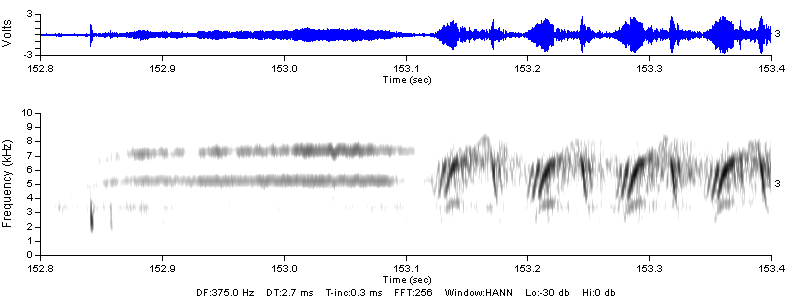Usually when I record a birdsong I call out the name of the species only if I see it and can identify it visually. That was a necessity for this bird, if I was ever going to use the recording, because the sound was a little unusual. In real time, I noticed a nearly continuous stream of sound at roughly the same amplitude and frequency range, but some of it sounded like calling and some it like singing. The simple mewing notes suggested that a Blue-Gray Gnatcatcher had found its way up here from the Rogue Valley, or perhaps the outpost on Mt. Pisgah. The more complex, song-like figures, suggested a Song Sparrow. Try it yourself without looking at the moving sonogram. So, I waited for it to move, confirming that it was one bird and not two, then I waited to see it well enough to confirm my emerging suspicion that it was the coyote of the birdsong world, the Bewick's Wren. Some Bewick's Wren songtypes, and they have many, are as simple as Spotted Towhee songs (April 11), some nearly as complex as the songs of Song Sparrows. The addition of notes between songs was a new wrinkle for me, although I heard it from another bird a few days later. So, be ready with "Bewick's Wren" when you can't place a birdsong emanating from a bush in western North America.
While we're here, let's look closely at the bird's virtuosity, as revealed by the sonogram. First, a couple of principles: 1. Sonograms are time series, and by convention they are read left to right. A trace cannot double back on itself, just can't be done. 2. Two traces that overlap are made by two birds. There are important exceptions to this principle, but in the present case, if one of those mewing notes had been overlapped by one of the songs it would have signified two birds. I thought at first glance that the note at 0.08 might be overlapped by the trill just to its right. But careful examination reveals a slight gap between that pure tone (flat trace) and the almost vertical sweep of the first note of the trill. Just enough time, it seems, for the bird to "switch gears." Try doing that on a clarinet.
Take a look at the detail below. There is a clean stop to the 5 kHz whistled tone. The first note of the trill starts at least a kHz lower, 36 milliseconds later, with no elision. Full stop. Fresh start. Now, I don't know, it's merely a conjecture based on the findings of the late Rod Suthers on the two-voice capabilities of songbirds, but I would predict that the tone is made by one side of the voice box (called the syrinx), and the trill is produced by the other. The two are independent. They can produce different notes at the same time, this being the major exception to Principle 2 above. But often, they alternate so as to produce crisp boundaries like this one. Result, a wren sounding like a gnatcatcher and a Song Sparrow at the same time. Wait until you hear about the Northern Cardinal.

For more Bewick's Wren songs, click "Bewick's Wren" in the Ebird box. For a very nice Orange-crowned Warbler song from the same spot, follow the link to my Ebird checklist.